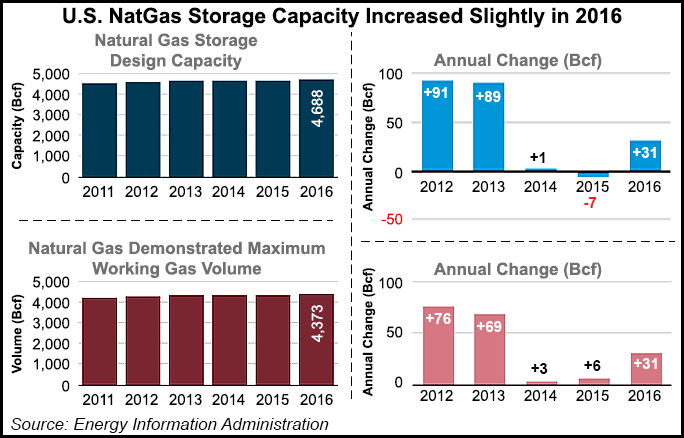Infrastructure | Markets | NGI All News Access
EIA Data Shows Little Change in Lower 48 NatGas Storage Capacity
Lower 48 natural gas storage capacity has barely increased over the last three years due to a variety of factors, reflecting market trends that could eventually lead to a reduced reliance on storage supply during times of elevated demand, the Energy Information Administration (EIA) said in a Today in Energy note on Tuesday.

The agency uses two measures of storage. Design capacity is the sum of the Lower 48’s 385 active storage fields and demonstrated maximum working gas volume is the sum of peak volumes reported by those facilities.
Year/year design capacity increased slightly by just 0.7% in November 2016, growing from 4.658 Tcf in November 2015 to 4.688 Tcf. EIA published updated estimates of storage capacity based on data for the end of November, which is when storage levels have reached their highest points for the year.
Last year’s gain of 31 Bcf compares to a decline of 7 Bcf for the same period ending in November 2015 and a gain of just 1 Bcf for the period that ended in November 2014. EIA data shows that design capacity increased by 91 Bcf in 2012 and by another 89 Bcf in 2013.
No new storage facilities have entered service since 2013. The EIA said last year’s gain resulted from a combination of expansions at existing facilities, reclassifications from base gas to working gas and the restoration of an inactive facility.
Slight changes over the last three years, EIA said, are likely due to higher levels of natural gas production, the proximity of that production to consuming markets in the Northeast and Midwest and the lower price premium for gas during winter months. Lower 48 dry gas production declined last year for the first time since 2005.
Demonstrated maximum working gas volume increased last year. It reached 4.373 Tcf, compared to the 4.342 Tcf in 2015.
The 2016 injection season began last April with a record high start after the warm 2015-2016 winter and hit an all-time high storage level in November at the beginning of the most recent withdrawal season. As a result, EIA said many storage facilities reached new demonstrated maximums last year.
© 2024 Natural Gas Intelligence. All rights reserved.
ISSN © 1532-1231 | ISSN © 2577-9877 |
